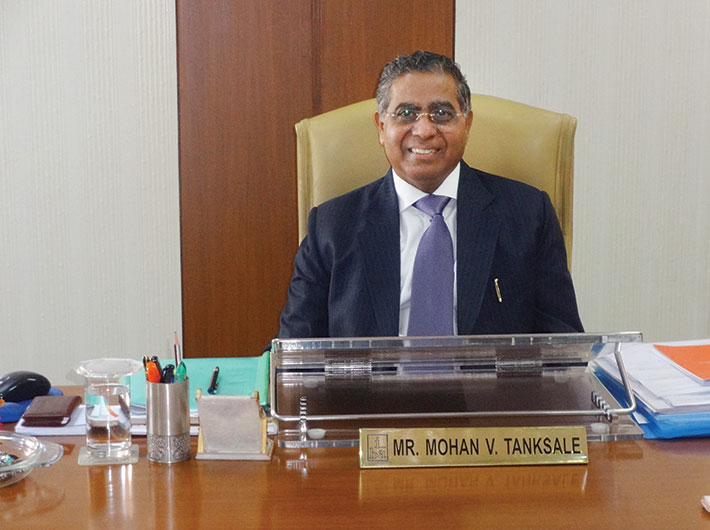MV Tanksale, the former head of Central Bank of India, now heads the Indian Banks’ Association (IBA), a consortium of 181 public, private, foreign and urban cooperative banks. In an interview with Srishti Pandey, he talks about coordinating the FI efforts of all member banks, helping banks solve the BC attrition issue and why more focus should be paid on people who will be the main drivers of FI. Excerpts:
From heading a bank to now being at the helm of affairs at IBA, what is the kind of transition you have had to make?
The role of the chairman is that of ensuring the execution of the bank’s commitment. Now, as chief executive of the IBA, I need to ensure that the complete ecosystem is in place so that the banks can fulfil their commitments. [The ecosystem consists] all the stakeholders – government, RBI, UIDAI. Recently all banks submitted their latest financial inclusion plan for 2013-16 to the RBI. Also, the UIDAI has expectations that wherever Aadhaar numbers have been allotted, the seeding should be completed by banks. The government finally wants that all the DBT payments should be routed through the Aadhaar linked bank accounts. Now, every stakeholder has their own expectation and the most important link which will put everything together is the business correspondent (BC) agent.
So we at the IBA are looking at solving the problems that banks are facing in making use of the BC model. We are looking at identifying the concerns that the BCs have and solve them so that the BCs can work efficiently. And so we do a lot of coordination between the various entities. There is a working group at the IBA level which sits every quarter to discuss the various issues related to FI and feedback is given to the IBA chairman who represents these issues to the RBI on the policy making occasions.
What exactly are the issues regarding the BC model?
One thing that I would like to point out here is that the bankers have done enough work for the acquisition of accounts. They have also reached out to villages with population of only 1,000 or even below 1,000 through the various models like base branches which would be around 50,000 in the country. Then there are ultra-small branches (USBs). So each bank has opened similar numbers of USBs and all the BC agents operating in those areas are linked to the USBs. Now what is important is that the BC agents should find this job a stable source of earning their livelihood which should be sustainable and this can only happen when they can generate a huge volume of work. Volumes are important because banks cannot pay out salaries to these agents without looking for the business to happen. So the first stage is over wherein accounts have been opened, the next stage is that we should get deposits from them, that is, if the DBT payments are happening, they should return as deposits in the bank. The third stage then is that the BC agents should find out what the credit requirements are. So banks are also training those BC agents to become business facilitators and also pay them for certain incentives where he is not taking decision on credit but he will do other things around facilitating credit and then take the villager to the bank. Let me tell you that if all this activity starts happening in 75 percent of the accounts that have been acquired it will be an absolutely successful activity. But to reach that 75 percent is the actual challenge.
And where exactly are we right now?
I think we are hardly at about 20-25 percent.
But isn’t that because BCs have not been encouraged yet to talk about credit facilities to rural customers?
They certainly can talk about loans. They are not allowed to negotiate or sell that product because this ultimately is a question of taking credit risk for the bank. On what basis can a BC agent promise a loan? There could be possible abuse of the situation. So what we are saying is that the BC agent should identify the needs of the borrowers and bring them close to the bank. Since base branch managers do visit the USBs and villages, they can be told about the credit-seeking borrowers in the villages and once the loans are given out they can ensure timely recovery of these loans.
Apart from the BC model, should not banks start looking at the CSC network as an efficient alternate delivery model?
Many banks are doing kiosk banking. This model is only successful where there is a large population to avail the services of a kiosk because it needs larger investment as compared to a BC agent who only needs a hand-held device. In this model connectivity is the most important thing and so unless there is connectivity everywhere, this model will not work. Next, state governments should also have those facilities in place whereby government services like availing birth certificate, death certificate, etc. should be available online. The kiosk model undoubtedly is a very good model and SBI is mostly operating through the CSC model. Most banks will gradually switch over to this model but it depends on how this model can be made even more viable. Secondly, if banks are having a kiosk model only in villages with population of 2,000 and above then what happens to the villages with lesser population where kiosks may not be successful? Banks will have to put in place a composite model so that kiosks and BC agents can co-exist.
So are you saying that individual BC agents will always exist?
Yes, I don’t think banks can do away with the BC agents because it is not possible to put up kiosks everywhere. There are six lakh-odd villages in the country and we hardly have around one lakh villages with population above 2,000 which can be catered to through kiosks. We do require BC agents to serve in the remaining villages.
How many villages have banks been able to reach out till date?
I think we have reached out to roughly around three lakh villages so far.
Do you think there is a shift in the way banks now look at FI?
Comments that banks are looking at financial inclusion as policy compliance is largely coming only from the media but that is not the reality. Everyone is committed to it because they have all realised the business potential of moving to rural pockets and this is evident from the number of rural branches sprouting up every year. And I suggested to the RBI that branch expansion is happening on a front-loading basis and possibly that activity has emerged after 12 months. There is no doubt that whatever investments have happened vis-a-vis the return on investments is still not breaking-even. For breaking-even the volumes need to be created and for that banks need to have the perfect last mile connectivity. Hence, it is very important to have a motivated set of BC agents or kiosk operators working on the ground who can efficiently generate volumes.
How close are we then to generating bulk volumes?
This is a continuous process and it may take another three to five years. We do not know. But when the entire '5,00,000 crore subsidy is routed through the formal channel, banking will definitely become a big activity.
Some of the recommendations and targets set by the Dr Nachiket Mor panel have not gone down well with many bankers and experts. Your views?
I think we should not pre-empt because bankers are still deliberating the report. We have submitted our comments to the RBI. These things have to be understood while sitting across each other so that a healthy discussion and debate can take place and our ideas converge. Hence, making any comment on the report will be too early for me.
Different states have achieved different levels of FI. For example, the UNDP has called the MP model an excellent one. Would you say that different state governments have shown varying levels of interest towards this objective?
As a former chairman of Central Bank of India, which is the SLBC in MP, I definitely claim that the MP model has been designed very well because from the first day, the state government has been operating on the concept of shadow villages. In MP, there are not many villages with a population above 2,000 and so the state government realised that the population criteria for reaching out to the unbanked areas would never work. Also the bureaucratic machinery of the state is very efficient and extremely committed to the task of reaching to the last mile and that is why people are talking about the model. The point to note here is that the state government had identified their challenges from day one and have constantly been working towards addressing these challenges. As an SLBC coordinator, I would like to claim that there is perfect coordination between the state government, bankers, NABARD and the RBI. All the four key entities are working in unison and that is the reason for the state’s success.
Is technology our main strength or constraint for achieving FI?
I don’t think that technology was ever our main strength or constraint. Our strength is the person who is going to be ultimately using that technology. Merely having technology is not going to serve the purpose and we need qualified people to use this technology and deliver the service. While technology will certainly make a difference in delivery model, the ultimate job will have to be done by a person. So for me people are above technology.
Finally, how do you see the arrival of new banks boosting the FI goal?
The basic premise on which the applicants will get the new licences is that 25 percent branches will have to be opened in rural areas. So the commitment is required from their side. However, urban areas are often overlooked even though there is so much scope for FI there. There is a huge population of migrant labour in these areas and they should also be brought into the formal banking fold. So there is a lot of work for the existing banks and new ones to do in terms of including every Indian into the formal banking channel.

